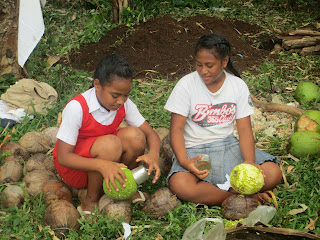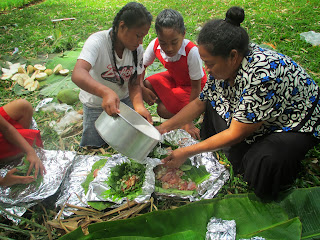Another year, another
Thanksgiving celebrated in Tonga. In an interesting twist, we celebrated on the
same day as my birthday. In the US my birthday can never be on Thanksgiving as
the 28th is the latest the holiday can possibly fall on, but as we
celebrated on Friday the 29th, I was fortunate enough to enjoy my
birthday by eating my fill on one of my favorite holidays with many of the
friends I have made during my time here.
Hosted at Don and Norie’s, it
was an international affair. Eleven of the 13 Peace Corps volunteers were able
to attend, including all 6 of the new recruits. Three of the Australian volunteers
attended as well, one arriving with her Dutch boyfriend and her visiting
mother. Last but not least, a Japanese volunteer celebrated her first
Thanksgiving with us, a 20 year old American friend of ours who lives in Vava’u
came, and a Tongan girl about my age who is leaving on her Mormon mission to
Idaho in a few weeks joined to finish the party.
The food was plentiful and
delicious – it was as if we combined the American need to overeat on
Thanksgiving with the Tongan culture of food that has inevitably rubbed off on
us. We had many of the Thanksgiving staples. A turkey that we had brought from
the main island, stuffing, mash potatoes, and cranberry sauce. We even added
our own twist to the staples with spaghetti and meat sauce, salads, green
beans, latkes, pumpkin soup, vegetable fried rice that I had made and so much
more. As tradition would have it, I ate way too much of the food, especially
the turkey which I hadn’t eaten since last years Thanksgiving, and was
absolutely stuffed.
We didn’t say what each of us
was thankful for but it still felt like a true Thanksgiving. Just with a Tongan
twist. One of the volunteers even made place cards with each of our names on
them. Due to the heat and the lack of space, we laid down mats outside of the
house and sat on the floor Indian style. We laughed and we joked, a bunch of
people from all over the world bonded together through their lives in Vava’u.
To finish the night, and in a moment that surprised and deeply touched me,
Norie, who is an amazing cook and baker, brought out a chocolate cake for me
with 24 written in candles. Not expecting such a celebration, I was profoundly
happy and thankful for the new friends I have made in Vava’u and their ability
to surprise me even after all this time.
Now, in a short list, here are
some of the things I am thankful for:
1. The incredible way Tongans say goodbye. When you say bye to a person
you say their name then shout eeehhhhh!!!! Afterwards. They reply with io but it sounds more like yyyoooo!!!
And then they do the same for you. It goes something like this. Sifa
eeeeehhhhh!!!!!! YOOOOOOO!!!! Soni eeeehhhh!!!!! YOOOOOO!!!! It is spectacular
and I am totally bringing it back to America.
2. The ease and safety of hitch hiking – it makes not having a car no
problem and I meet someone new every week
3. The Tongan use of umbrellas – always as shade in the sun but never in
the rain
4. Living in a tropical paradise
5. Continuously seeing the phrase “twerk” online, but being blissfully
ignorant of the dance move as the internet is too slow to download youtube
videos
6. Roast pig severed over a skewer
7. Tongan generosity, my school, and the three villages I reside in
8. All of my friends and family back home who have supported me so much
since the moment I left for Tonga
In others news, this week was
our school graduation. As is the Tongan custom, many of the parents attended
the ceremony that included a short prayer, a welcome speech by the principal,
and the lining up of the kids from the best performing student to the worst in
each class. I was hoping we would just announce the best student, but in the
end we decided to reveal their exact class placements. As the kids’ names were
called, parents would come up and tuck dollar bills into their shirts or place
a necklace made of candy over their heads, a Tongan staple. It was a somewhat
brief and anticlimactic finish to the school year, but I did feel a sense of
pride watching my students complete my first year of school.
Also, this will be my last post
until possibly mid-January. Next week, Monday through Thursday, will be Camp
GLOW and GROW. The next day on Friday I am flying to the United States. When I
return to Tonga in January and after I attend a training on the main island, I
promise to write about what I hope will be the success of the camps and
anything else interesting that had since happened to me.
Thanks for reading and see you
all in America soon.
The birthday cake
Thanksgiving Tongan style




























